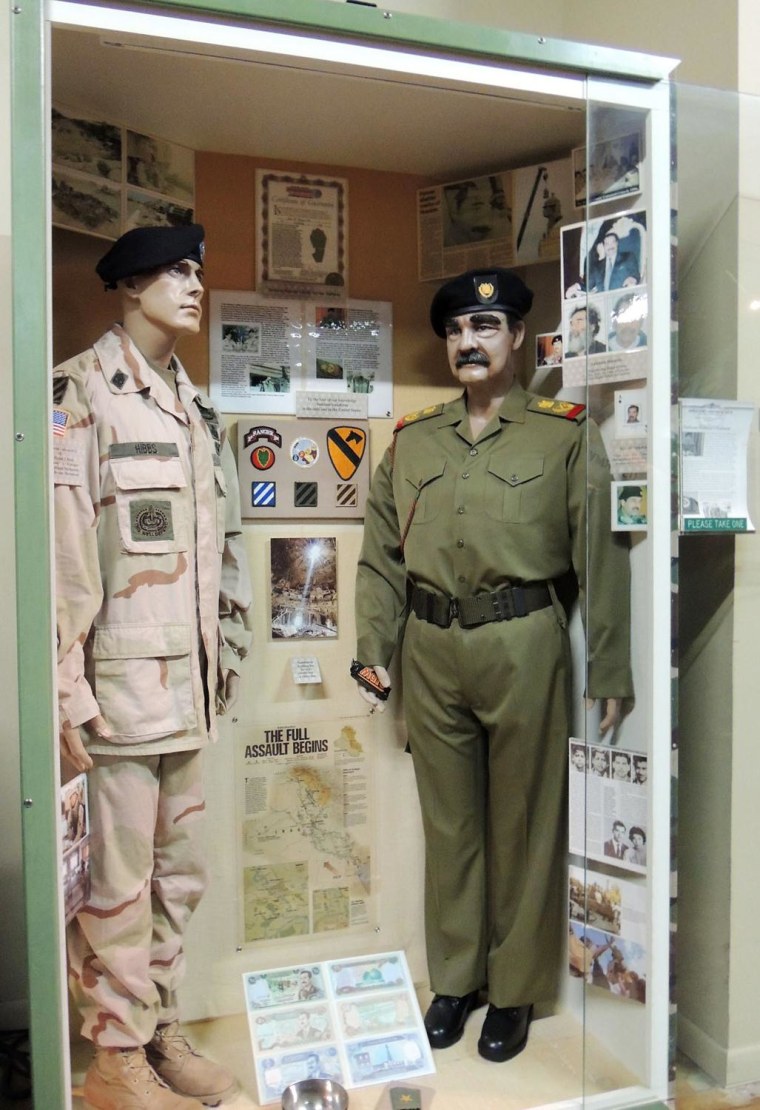A decade after Saddam Hussein's capture and seven years since his execution, his legacy in the United States is relegated to random displays of memorabilia: a bathroom sink in Mississippi, a life-sized replica in Florida of the uniformed Iraqi leader holding a Mars bar.
While the deposed dictator was known for his opulence, it’s these obscure oddities — turning up in lesser-known museums — that are giving Americans a personal insight into one of history’s most notorious despots.
“It’s one of those bizarre spoils of war,” George Bolm, curator of the Old Court House Museum in Vicksburg, Miss., said of Saddam’s porcelain sink being readied for display in the coming weeks.
“There’s an interest in military memorabilia, and this in particular is what gets people talking,” added Bolm, acknowledging the public's fascination with Adolf Hitler and other sensational historical figures.
Bolm said the sink was “liberated” from one of Saddam's homes in 2003 and donated two weeks ago by a group of American soldiers who were cleaning out storage.
He wasn’t sure from which of Saddam’s nearly 100 palaces and complexes the sink was taken, and whether the toppled tyrant actually washed his hands in it. The soldier who procured the sink declined to be interviewed.

The bathroom basin stands about 3 feet tall with gold touches on the knobs and a marble, almost iridescent finish.
After putting it on display, “we may even use it as a working sink,” Bolm said.
The museum is also putting up another object donated by the soldiers: an Iraqi flag taken from the Iraqi Parliament building in Baghdad in April 2003 — the month U.S.-led forces took the capital.
“It’s in excellent condition,” Bolm said.
Meanwhile, other items appearing to have belonged to Saddam and his family were introduced this month at the Oklahoma Historical Center in Oklahoma City, which has a larger exhibit on warfare.
Among the objects on display is one of Saddam’s uniforms, martyr banners from the paramilitary Fedayeen fighters and firearms.
Matt Reed, curator of American Indian and military history, said he studied the pieces and was impressed.
“One of the things you can look at is the tailoring and the quality of materials,” he said. “[Saddam’s] uniform in particular is above and beyond what you would see on field-grade officers or higher, even in the Republican Guard. While someone could reproduce [the uniform], the likelihood is pretty slim.”
The museum typically exhibits items with ties to Oklahoma. Those from Iraq were donated by retired Army Lt. Col. and former Oklahoma State Sen. Steve Russell, who commanded a battalion in Tikrit sent to hunt down Saddam after he was ousted from power.
“For years I have kept low key about these artifacts,” Russell said in a statement to the museum. "I realize that they are an incredible part of our nation’s history that should be enjoyed by the public and hope the display will call to remembrance the soldiers wounded and lost during the hunt and capture of Saddam.”

The image of a scraggly Saddam being ripped from his spider hole on Dec. 13, 2003, became a pivotal moment in the war.
“He was caught like a rat,” Maj. Gen. Raymond Odierno famously said at the time.
But during the months of the Iraq invasion — and after Saddam was executed by hanging on Dec. 30, 2006 — some of his possessions as well as those belonging to the government went missing.
The Iraq Museum in Baghdad was looted of some 17,000 items, including sculpture heads, Assyrian ivories and ancient seals. An estimated half were eventually returned or recovered.
In July, U.S. Immigration and Customs Enforcement announced the discovery and return of a ceremonial sword that was lifted from Saddam’s office in Baghdad in 2003.
The 43-inch sword featured gold inlaid Arabic writing saying it was a gift to Saddam. After it was smuggled into the United States, it was offered in an auction last year in New Hampshire, where it was advertised as having been removed by the U.S. Army 126th Military History Detachment, according to Homeland Security Investigations.
A combat historian with the unit took possession of it when the U.S government didn’t want the item, the advertisement said. The historian told the auction house that he was allowed to keep it as a souvenir.
But the feds decided otherwise. While some modern items may be taken as war trophies, the sword was classified as a possible Iraqi cultural artifact.
Under the Department of Defense’s Office of Foreign Assets Control, Iraqi cultural property can’t be traded or transferred. Over the past few years, Immigration and Customs Enforcement said it has repatriated cultural objects — from Saddam-era paintings to AK-47 rifles to ancient gold earrings — brought illegally from Iraq.
Rick St. Hilaire, a cultural property lawyer in New Hampshire, said that while pillaging during wartime remains prohibited, the National Defense Authorization Act does allow the U.S. to confiscate enemy property. The Spoils of War Act allows that property to be transferred to someone else.
“A soldier, meanwhile, might be able to keep a contemporary war souvenir if the U.S. authorizes it,” St. Hilaire said in an email to NBC News.
It was through an auction that history buff John Piazza obtained a green service uniform once belonging to Saddam.
American troops in 2003 were locking down one of Saddam’s Baghdad palaces when a truck arrived at the gates. The vehicle was carrying dry cleaning, and the uniform, freshly cleaned, was inside one of the bags.
Piazza said the clothing was taken by a sergeant who was allowed to keep it after the company commander didn’t want it.
Piazza bought the uniform four years ago for his Armed Forces History Museum in Largo, Fla. Instead of using a faceless mannequin, he got a life-sized replica built of Saddam for the display. He even found a Mars bar — the chocolate treat discovered inside the disgraced dictator’s final hideout — to place in the mannequin’s hand.
“It’s a piece of history,” Piazza said of the uniform, “and now, here it is in Florida, for anyone who wants to see it up close.”
Related:
